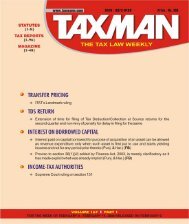CPT V24P7-Art1 (Content).pmd - Taxmann
CPT V24P7-Art1 (Content).pmd - Taxmann
CPT V24P7-Art1 (Content).pmd - Taxmann
You also want an ePaper? Increase the reach of your titles
YUMPU automatically turns print PDFs into web optimized ePapers that Google loves.
Landmark Rulings<br />
their two daughters. Subsequently, the parents<br />
were added as additional beneficiaries, when<br />
the original beneficiaries relinquished their rights.<br />
The said trust was dissolved and the assets<br />
were equally distributed among the parents.<br />
The AO made addition of amount received by<br />
parents to their total income. On appeal, CIT(A)<br />
held that the amount received by parents would<br />
be taxable as gift under section 56(2)(v), on<br />
following grounds:<br />
(a) Neither there was specific transfer nor<br />
gift by both the daughters to their parents;<br />
(b) As the sum was received without consideration<br />
and the said trust did not fall<br />
within the ambit of the word “Relative”.<br />
The Tribunal held in favour of assessee - It<br />
was held that undisputedly, the assessee had<br />
received the amount on dissolution of trust in<br />
the capacity of beneficiaries. Therefore, the<br />
amount received by the parents could not be<br />
termed as amount received by the beneficiaries<br />
“without consideration”. Therefore, addition<br />
made by AO was deleted and assessee’s claim<br />
had been allowed.<br />
690<br />
Statement by Tribunal in open Court<br />
doesn’t constitute an order, not rectifiable<br />
under section 254<br />
In Hari Om Soni v. ITO [2012] 23 taxmann.com<br />
349 (Agra - Trib.), the assessee filed miscellaneous<br />
application seeking rectification of the order<br />
passed by the Tribunal. Assessee contended<br />
that there was a mistake in the order of Tribunal<br />
as the Tribunal announced in the open Court<br />
that the issue stood settled in favour of the<br />
assessee.<br />
The Tribunal held in favour of revenue - It was<br />
held that raising and discussing queries during<br />
course of hearing for exploration of correct<br />
facts of case does not constitute an order under<br />
section 254(1). The order of Tribunal is said<br />
to be in accordance with section 254(1) only<br />
when order bears signature of both Members<br />
August 1 to 15, 2012 u TAXMANN’S CORPORATE PROFESSIONALS TODAY u Vol. 24 u 70<br />
}<br />
and is communicated to parties. Therefore,<br />
mere pronouncement during course of hearing<br />
in open Court does not amount to order under<br />
section 254(1) and same is not rectifiable under<br />
section 254(2).<br />
Service provided for support to<br />
representative office in India, not exempted<br />
under India-Poland DTAA<br />
In Dy. CIT v. Mohan Balakrishnan<br />
Pookulanagara [2012] 21 taxmann.com 115<br />
(Ahmedabad - Trib.), the assessee was employed<br />
by a Polish company. As per terms of<br />
employment, assessee was a ‘service provider’<br />
and he was to support establishment of<br />
company’s representative office at Bangalore.<br />
The assessee claimed that salary received from<br />
non-resident company in Poland was exempt<br />
from tax on the basis of Indo-Poland DTAA.<br />
The AO opined that the certificate issued by<br />
the Polish company referred the assessee as<br />
a ‘service provider’, which showed that assessee<br />
was not a part of top level management and,<br />
therefore, the conditions specified in Article<br />
17(2) of the Indo-Poland DTAA were not fulfilled.<br />
Accordingly, the AO rejected the assessee’s<br />
claim. On appeal, the CIT(A) allowed the<br />
assessee’s claim.<br />
The Tribunal held in favour of assessee - It<br />
held that the function to support an establishment<br />
and preparing organization can at best be termed<br />
as a management function but cannot be equated<br />
with ‘Top Level Managerial Position’. Business<br />
dictionary defines top management as ‘The<br />
highest ranking executives (with titles such as<br />
Chairman/Chairperson, CEO, Managing Director,<br />
President, Executive Directors, Executive vice-<br />
Presidents, etc.) responsible for entire enterprise.<br />
Top management translates the policy<br />
(formulated by the Board of Directors) into<br />
goals, objectives and strategies and ‘projects<br />
a shared vision of future’. It makes decisions<br />
that affect everyone in the organization and<br />
is held entirely responsible for the successes<br />
and failures of the enterprise. Viewed in light<br />
}











![“FORM NO. 3CEB [See rule 10E] Report from an ... - Taxmann](https://img.yumpu.com/45480232/1/190x245/form-no-3ceb-see-rule-10e-report-from-an-taxmann.jpg?quality=85)





